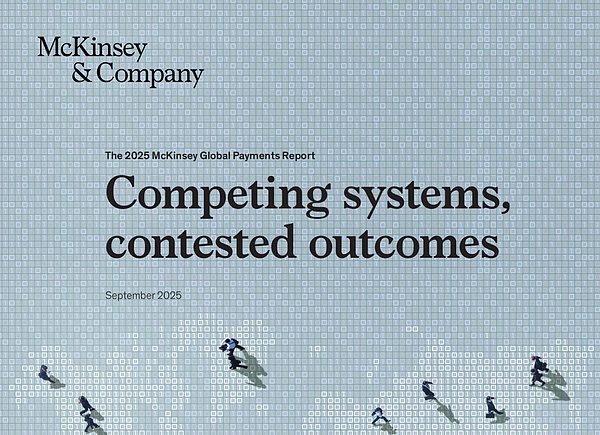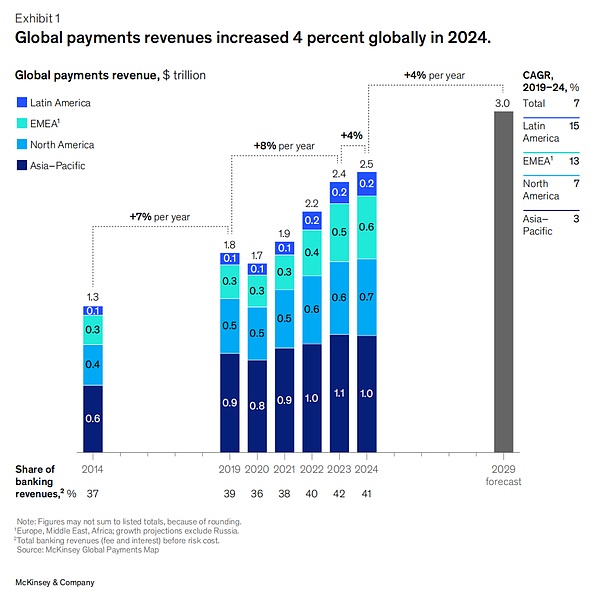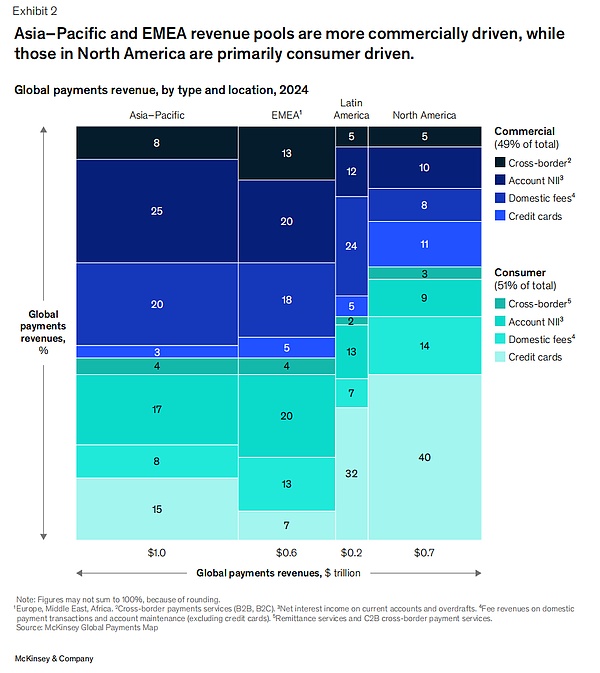Written by: Will A-Wang
The payment industry in 2025 is at a turning point. The once universal pursuit of efficiency has now evolved into competition among various market systems, each with its unique philosophies, capabilities, and limitations. Some systems focus on achieving control and interoperability through central infrastructure, while others prioritize decentralization, programmability, and private tracks. There are also systems that embed payment functions into platforms, devices, and networks traditionally unrelated to finance.
The way funds flow is becoming as critical as the amount of funds. Whether it’s wage payments in Southeast Asia, inter-company settlements in Europe, or retail checkouts in Latin America, the design choices made today are shaping the payment landscape for the next decade and will determine who will lead, who will follow, and who will fall behind.
The global financial system is influenced by non-financial factors such as tariffs, data governance rules, energy constraints, and national security priorities. The increasing fragmentation in the payment sector reflects that the entire financial system is evolving into a regional puzzle composed of different standards, timelines, currencies, and trust anchors.
In this context, the payment industry remains the most valuable part of financial services, generating $2.5 trillion in revenue from a value flow of $20 trillion (0.125% take rate), supporting a global transaction volume of 3.6 trillion transactions.
Thus, we need to consider how to integrate the payment and finance of stablecoins/tokenized currencies into the entire global payment landscape, or from a Fintech perspective, who will integrate and how to integrate these fragmented systems caused by geopolitical factors, and how to adapt to the development of the next payment era based on their own advantages. This is a question all market players need to think about.
The "2025 McKinsey Global Payments Report" delves into the rise of diversified payment tracks, the impact of digital assets, and the transformative power of artificial intelligence, providing a roadmap for success in the rapidly evolving global payment ecosystem. The report highlights the key elements needed to remain competitive in a fast-changing environment. This report is based on McKinsey's "Global Payments Map," which covers data from 50 countries and over twenty payment methods, accounting for 95% of global GDP. The report is divided into three main parts:
A foundational forecast of industry growth before 2029, analyzing how economic fluctuations and policy changes lead to significant differentiation in profit margins and revenue structures. It emphasizes whether new revenue points can emerge from integrating multiple payment tracks, which is a crucial driver of payment development.
The main forces reshaping the payment landscape, including AI-native operations and the monetization of AI agents, emerging models of programmable payment liquidity, and regulated digital currencies. It focuses on what changes these emerging forces will bring to existing models.
Key areas that payment operators should focus on during the transformation, concentrating on agility, architecture, and trust. It emphasizes how to capture value.

1. Payment Revenue in the New Economic Era
From 2019 to 2024, global payment revenue is expected to grow at an average annual rate of 7%. Driven by rising interest rates, interest income is projected to account for 46% of total revenue in 2024. The growth rate for that year is expected to drop to 4%, significantly lower than the 12% in 2023. Reasons for the slowdown include: peak interest rates, weakening macroeconomic conditions, structural expansion of low-yield payment methods, and ongoing fee compression.
Regionally, Latin America is expected to grow by 11%, while Europe, the Middle East, and Africa (EMEA) and North America are expected to grow by 8% and 5%, respectively, with Asia-Pacific (APAC) declining by 1%. Nevertheless, payments remain the most valuable sub-industry in finance, with an average return on equity of 18.9% in 2024, with some institutions exceeding 100%.
However, as interest rates peak and deposit behaviors change across multiple countries, net interest income is expected to grow at an average annual rate of only about 2% (until 2029) without significant shocks. At the same time, consumers are increasingly leaning towards low-cost methods such as account transfers and digital wallets, which will also slow the growth of transaction-based income. Ongoing pricing pressures (especially in card-based ecosystems), tightening regulations, and the rise of platform-based payment experiences are squeezing the fee model. Therefore, we predict that the industry's revenue growth rate will maintain at 4% annually before 2029, potentially dropping to 3% if global disruptions occur, or reaching 6% if productivity improvements accelerate. Based on a 4% growth rate, the total market size is expected to reach $3.0 trillion by 2029.

1.1 Global Payment Trends
Overall, global payment revenue is almost evenly split between consumer and business segments, but there are significant regional differences.
North America leans towards consumer payments, as credit cards serve both as a primary payment tool and a borrowing means, reflecting the maturity of the consumer credit market and strong card loyalty programs.
The Asia-Pacific region leans towards business, with 25% of revenue coming from net interest income (NII) on business accounts, highlighting the deep relationships in corporate banking and the reliance of rapidly growing economies on deposit interest.
EMEA has the most diverse structure: 20% of revenue comes from NII on business accounts related to trade and treasury activities, and 20% comes from NII on consumer accounts, benefiting from Europe's higher savings base.
Latin America, similar to North America, also leans towards consumers, with consumer credit card income accounting for 32% of total revenue, reflecting the importance of revolving credit and consumer reliance on installment payments.

1.2 Payment Development Trends Under Revenue Structure
The global cash usage rate continues to decline, with its share of total payments dropping from 50% in 2023 to 46%. Account-to-account (A2A) payments are becoming increasingly popular, especially transactions completed through digital wallets, which currently account for about 30% of global point-of-sale (POS) totals, with markets like India, Brazil, and Nigeria leading the way.
As transaction volumes shift towards low-yield tracks like instant payments, monetization becomes more challenging; this issue is particularly pronounced in markets with strict regulations on interchange fees and processing fees. We expect that new economic and fee models will gradually emerge in the A2A space, potentially following India's approach—where banks have begun charging payment aggregators for Unified Payment Interface (UPI) merchant transaction fees.
In business-to-business (B2B) payments, digitization has been fully rolled out, but it mainly focuses on low-profit channels like bank transfers and instant payments. To capture value, companies (especially those centered around software) are investing in value-added services, including invoice automation, reconciliation, and working capital tools; these services are particularly important in small and medium-sized enterprises and industries like healthcare that still rely on manual processes.
Finally, new technologies continue to bring opportunities and threats. From tokenized currencies and digital currencies to AI-based fraud prevention and liquidity management, innovations enhance security, efficiency, and reach. However, the level of adoption varies widely. Regulatory uncertainty, infrastructure gaps, and inconsistent technical standards mean that progress is only occurring in isolated pockets.
2. Three Forces Reshaping Global Payments
Three structural forces could fundamentally change the way funds flow between individuals, businesses, and intermediaries:
Increasing fragmentation and regionalization of payment systems;
Large-scale application of digital assets in payment scenarios;
The transformative potential brought by artificial intelligence.
2.1 Fragmentation and Regionalization of the Payment Landscape
The global payment ecosystem is entering an unprecedentedly complex phase, characterized by the high interconnectivity of goods, services, and people. Over the past 30 years, globalization has ensured the smooth flow of cross-border funds. However, geopolitical events have prompted some countries and regions to reduce their reliance on global standards and systems. For example, sanctions against Russia have excluded it from international card organizations, leading it to rely on the Mir card for domestic transactions and collaborate with China UnionPay to meet international demands. Some countries and regions are promoting "payment sovereignty" to reduce dependence on global intermediaries; the European Central Bank is vigorously promoting a large-scale system centered on Europe.
At the same time, technological advancements are accelerating the growth of localized and regionalized payment systems. The construction of instant payment infrastructure is particularly crucial, as it creates excellent user experiences (typified by Brazil's Pix, Spain's Bizum, and India's UPI). The increasing interoperability among domestic instant payment systems provides new pathways for cross-border payments beyond traditional standards. Notable and rapidly developing cases include Pix's internationalization in Latin America and the expansion of the National Payments Corporation of India (NPCI) into the Middle East and Southeast Asia. Meanwhile, the rapid proliferation of stablecoins is also creating a new channel distinct from traditional payment tracks.
These geopolitical and technological changes are reshaping the payment landscape, leading to stronger regionalization and diversification. It is becoming increasingly unlikely to return to a fully globalized payment system as the forces driving fragmentation have already been set in motion. However, many alternative payment systems face obstacles during their expansion: poor user experiences, unclear value propositions, governance flaws, and a lack of supporting legislation in key markets are all common issues; in some scenarios, traditional legacy systems demonstrate sufficient resilience, even bypassing or defeating new solutions.
Therefore, the payment landscape is evolving towards two outcomes that are more fragmented than the current state: one is a diverse ecosystem of "multi-tracks + global keys"; the other is a divided world of "increased localization + declining global standards."
Scenario A: Multi-Track Ecosystem with a "Global Key"
In a more optimistic scenario, geopolitical tensions stabilize or ease, and payment standards remain strong, serving multiple payment scenarios and customer types like a "global key." The service scope can be broad or narrow—from online shopping to a range of value-added services; the service depth can be deep or shallow—from cross-border financial solutions targeting specific industries to simple remittances for the general public.
In this environment, all participants must face multiple challenges: monitoring and regulating the flow of funds traversing multiple tracks, dealing with the significant economic differences between different use cases and systems, and completing technical integration between systems. This may give rise to a batch of "integrators" and "aggregators" that can seamlessly stitch together multiple payment systems. In this scenario, while payment systems may be more fragmented than now, they can foster innovation and specialization, allowing diverse solutions to coexist and meet the needs of niche markets.
Scenario B: Fragmentation Upgrades, Global Standards Eroded
If global trade and commerce continue to face significant challenges, and geopolitical tensions escalate, countries may increasingly rely on local and regional alliances, gradually distancing themselves from global flows of goods, services, and people. The emergence of this scenario is set against the backdrop of the global failure to construct a framework that allows "global systems" and "local systems" to coexist. At that point, payment systems will inevitably trend towards regionalization.
Countries and regions will prioritize resilience and self-sufficiency, leading to the emergence of more bilateral agreements, intermediary currencies, and alternative payment systems, gradually distancing themselves from global standards. Over time, regional systems and payment tools will dominate various use cases, fundamentally reshaping the financial landscape. International connectivity will become more challenging, profoundly impacting the payment technology stack, especially for institutions with multinational and global layouts. This may accelerate the adoption of stablecoins and tokenized currencies.
Although international connectivity is smoother in the first scenario, both scenarios imply that the previously unified global payment landscape will further fragment and complicate, with solutions becoming more localized. For businesses and financial institutions, adapting to this new reality requires flexibility, innovation, and a deep understanding of the forces driving the flow of funds.
2.2 Accelerated Adoption of Stablecoins and Tokenized Money
Stablecoins and tokenized currencies are increasingly becoming important components of the financial system, although they have yet to cross the threshold of widespread adoption. The industry is rapidly expanding—stablecoin issuance has doubled since early 2024—but their share in the global daily payment volume, which amounts to trillions of dollars, remains limited: the current average daily transaction volume is about $30 billion.
Multiple signals indicate that stablecoins are approaching a "breakthrough" moment. The primary factor is the increasing clarity of regulatory rules: the United States (with the recently passed "GENIUS Act"), the European Union, the United Kingdom, Hong Kong, and Japan have all introduced or improved regulatory frameworks, clarifying key requirements such as licensing, reserve management, anti-money laundering, and customer due diligence. Whether cross-regional frameworks can align will determine whether cross-border stablecoin businesses can succeed; the clarification of rules itself will lower entry barriers, particularly benefiting traditional financial institutions and enhancing market confidence in stablecoins.
Technological infrastructure is also rapidly upgrading: by migrating transaction processing from the mainnet to more scalable Layer 2 solutions and adopting more efficient consensus protocols, throughput continues to improve; user-facing digital wallets and bank-grade custody solutions are becoming increasingly reliable and accessible; advanced on-chain analytics tools enhance security and compliance capabilities.
More compelling drivers come from real-world demand. While stablecoins initially gained popularity only in niche areas like cryptocurrency asset trading settlements, their potential has been recognized for broader use cases: tokenized deposits allow customers to earn interest intraday and be available at any time; stablecoins can provide "24/7" real-time settlement, becoming an alternative to traditional correspondent banking networks; in regions with significant local currency volatility, stablecoins pegged to major global currencies can help consumers hedge against inflation. Institutional-level applications are also beginning to emerge, such as B2B treasury management, supply chain financing, and repurchase agreements. Additionally, the "programmable" nature of stablecoins can give rise to new scenarios, including solving custody challenges and restricting government benefits to specific consumption categories.
Over the past 18 months, several high-profile announcements, collaborations, and mergers indicate that the industry is fully committed to capturing the value of tokenized assets. However, widespread adoption also brings risks that must be managed prudently. Although major market regulations are becoming clearer, there is still a lack of a unified and coherent regulatory framework globally, which could lead to uncertainty or even market disruptions. If a certain issuer has insufficient reserves, the stablecoin could become unpegged, leading to a collapse of trust; if a leading stablecoin fails, the ripple effects could spread to the broader financial system.
Moreover, for stablecoins to truly gain traction, end users need to shift from a "just a bridge for fiat currency exchange" temporary mindset to a willingness to hold them long-term. Once the majority of customers keep their funds in stablecoins, the funding sources and income models of traditional banks will be disrupted.
The rise of stablecoins is also in sync with the broader trend of "multi-track payments"—for example, merchant acquiring institutions simultaneously support card payments, A2A transfers, and stablecoins within unified solutions. Leading companies have already taken significant steps: PayPal now accepts multiple digital asset payments; Coinbase has launched a debit card linked to stablecoins, with credit card products soon to follow. Other service providers looking to meet customer needs related to stablecoins must decide: whether to build capabilities in-house or collaborate with aggregators and integrators.
3. Pathways for Payment Participants
As the global payment landscape is restructured into a mosaic of diverse tracks, digital assets, and intelligent AI agents, numerous possible pathways will emerge for industry participants.
This chapter dissects the key choices faced by payment institutions, merchants, platform providers, and solution experts, exploring how each segment can position itself, continue to innovate, and capture value in an increasingly "decentralized, programmable, and real-time" environment.
3.1 Payment Providers: Competing for Brand and Trust
As AI agents begin to dominate more consumer journeys, traditional competitive strategies relying on "product differentiation + user experience" may become ineffective. Convenience and personalization will become basic thresholds, with the main battleground shifting to "brand trust and relationships"—whoever can control the interaction interface (whether direct or embedded) will be able to influence consumer decisions in a highly sticky and irreplaceable manner.
At the same time, new tracks, stablecoins, and programmable currencies will rewrite the economic model of consumer payments. Intelligent agents optimizing "when and how to pay" may squeeze interchange fee revenues and interest margins, putting pressure on local/regional players and challenging the dominance of global giants. Large institutions and solution experts that have long relied on "settlement, credit, and liquidity inefficiencies" for profit will need to reshape their value propositions to avoid being "disintermediated" by smaller players and customers.
The ultimate winners will be those who create intelligent, embedded, secure, and emotionally resonant experiences around the "agent-driven journey": not only able to anticipate needs and "translate" complex technologies into intuitive experiences but also possessing explainability and deeply aligning with brand trust commitments.
Countries' emphasis on "payment sovereignty" and local solutions will benefit local/regional players while limiting global players. Local institutions can become the "trust anchors" of local ecosystems (instant payments, identity layers, central bank digital currency platforms), promoting interoperability, connecting networks, and complying with local policies; regional players (such as Europe’s Wero and Brazil’s Pix) can lead economic blocks by establishing cross-border payment, digital identity, and data governance rules. Global players may turn to more flexible and open architectures to accommodate jurisdictional differences; in some markets, they may also consider partnering with emerging regional companies to bridge brand recognition and trust gaps.
3.2 Merchants: Retaining Customers with Payment Methods
As consumer expectations rise, merchants must provide seamless, scalable experiences that cover diverse payment methods, channels, and compliance requirements. AI agents increasingly controlling the demand side will force merchants to acquire customers in new ways and achieve new standards in "payment orchestration, smart checkout, and personalized offers."
Merchant payment service providers must upgrade from "supporting acquiring" to "providing autonomous payment infrastructure": features like intelligent routing, real-time settlement, automated compliance, and dynamic currency optimization will become default configurations. The greatest opportunity lies in building a "commercial empowerment layer" that helps merchants acquire, convert, and retain customers across multiple channels and regions. This layer includes acquiring services and further integrates merchant SaaS with payments. Early movers can turn the complexity of "regional tracks + tokenized currencies" into a competitive advantage through programmable APIs and embedded services.
3.3 Platform Providers: Becoming Ecosystem Enablers
"Large multi-product" platforms that span the value chain and multiple payment tracks have a natural advantage in upgrading capabilities with AI and programmable currencies, helping traditional clients like banks accelerate innovation. Their broad business scope allows them to orchestrate the complete end-customer journey and serve as the "control layer" for AI agents and programmable finance. Rich data resources further fuel large-scale decision-making and personalization.
However, many platforms, while "large," are "weak" in specific functionalities compared to experts. Blindly layering comprehensive new features may further widen the gap with specialized players, prompting customers to seek "best-in-class" solutions externally.
Therefore, platforms need to clarify strategic priorities, decide where to allocate resources, and effectively implement new technologies for different customer groups (banks, merchants, enterprises, individuals). With R&D and developer ecosystems, large platforms can maintain a leading edge in innovation in specific service areas.
3.4 Solution Experts: Unlocking Niche Value
Specialized participants—such as cross-border payment experts, single-track acquiring providers, and accounts payable/receivable automation vendors—face both opportunities and risks. The fragmentation of payment systems has spawned numerous edge cases and niche segments, perfectly suited for "point solutions" to delve into; however, the rise of agent-driven workflows and programmable currencies may commoditize those lacking unique intelligence, depth, or leverage.
Thus, the key to success for experts will be: targeting complex use cases rich in intellectual value and deeply embedding their capabilities within platforms and agent ecosystems; while also adapting to regional differences and retaining the ability to orchestrate larger workflows across tracks and segments.
Specific pathway examples include:
Transforming cross-border payment systems into "embedded engines" that allow platforms or agents to dynamically choose routes based on real-time rates, foreign exchange fluctuations, and settlement timeliness, deeply integrating with programmable wallets to achieve optimal cash movement across multiple currencies and tracks.
Upgrading KYC/KYB rule engines to a "programmable trust layer," allowing agent systems to adjust onboarding processes in real-time based on transaction types, jurisdictions, and customer profiles, achieving intelligent and differentiated onboarding.
4. Six Strategies for Thriving in the Next Payment Era
In the face of a "smart, programmable, interconnected" new payment era, participants can adopt the following six core strategies to seize new value.
- Design with "Smart Simplicity" as the Goal
As consumers and businesses increasingly rely on agents and automation, the key to trust and adoption lies in "keeping complexity to ourselves and simplicity for the customer." Simplicity, transparency, and personalization must be embedded in the core of products, allowing users to maintain complete control over their funds with minimal effort.
- Treat Interoperability as Infrastructure
Cross-border, multi-track transactions will become the norm for the foreseeable future. The ability to bridge different asset types, jurisdictions, and compliance regimes in real-time will no longer be a differentiating selling point but rather an "entry ticket." Participants need to build resilient infrastructures that natively support these needs.
- Push Intelligence to the Edge
Decisions must be made at the moment a transaction occurs, within the agent, and in programmable contracts. Routing logic, fraud detection, and liquidity management should be directly embedded in software agents, APIs, and workflows, rather than relying on centralized batch processing or manual approvals.
- Make Compliance Programmable
In the face of increasingly fragmented regulations, only players who can write "local compliance" into code will be able to scale. Modular policy engines and regional logic will replace manual processes and hard-coded rulebooks, achieving "one-click adaptation" to global compliance.
- Integrate into Ecosystems, Not Compete Against Them
In a modular, programmable world, victory belongs to layers that are "seen as foundational by others": whether it be intelligence, trust, liquidity, or connectivity. Independent moats will be eroded; roles embedded in larger ecosystems will endure.
- Build Trust "Upstream"
As AI and automation become the initiators of transactions, businesses need to design systems that are transparent, explainable, and capable of error tracing, allowing users and regulators to always know "what happened and why," thereby winning trust "before the transaction occurs."
5. Conclusion
The payment industry is not only adapting to new technologies or market changes but is fundamentally reshaping its infrastructure in response to geopolitical forces, emerging digital paradigms, and the accelerating pace of artificial intelligence. In this fragmented yet interconnected future, the key to success lies in the commitment to achieving seamless interoperability between diverse payment tracks and actively embracing complexity.
In the coming years, those who can turn challenges into opportunities and carve out new pathways in a world where agility, innovation, and trust become the most valuable assets will reap substantial rewards.
免责声明:本文章仅代表作者个人观点,不代表本平台的立场和观点。本文章仅供信息分享,不构成对任何人的任何投资建议。用户与作者之间的任何争议,与本平台无关。如网页中刊载的文章或图片涉及侵权,请提供相关的权利证明和身份证明发送邮件到support@aicoin.com,本平台相关工作人员将会进行核查。



